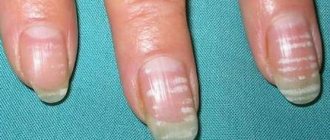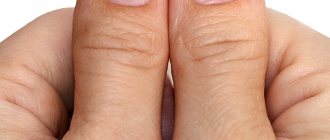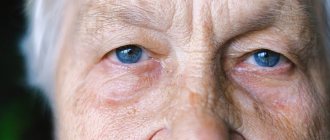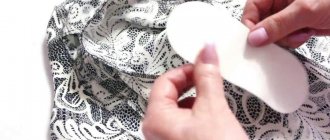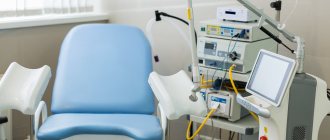What do white spots on nails mean?
08.08.2018
Many people have at least once noticed white spots or stripes on their nails - these are leukonychia. This cosmetic problem is quite unpleasant, since it becomes necessary to hide stains under bright varnishes, and their frequent use makes the nail plate thinner due to lack of oxygen. White spots appear because air bubbles get stuck between the keratin plates that make up the nail. Typically, several of these white spots appear on one nail at once, although they can form stripes and cover the nail completely. In the latter case, the situation needs to be corrected with the help of a doctor , as well as in a situation where leukonychia increases in size or is located on several nails at once.
Causes of leukonychia
- Mechanical damage . Impact, careless handling of the file, uncomfortable shoes, strong squeezing of the nails - all this causes the appearance of white spots. In this situation, a doctor's consultation is not necessary, as these white spots are similar to a bruise on the skin. You can deal with them using strengthening varnishes.
- Chemical exposure . Applying low-quality nail polish, washing off the decorative coating with an aggressive composition, detergents and cleaning mixtures can also cause the appearance of leukonychia. This situation can be prevented by using gloves, which should not be forgotten when cleaning and washing dishes. If you are sure that the white spots are caused by a chemical, you can treat them with a salt bath for 15-20 minutes.
- Fungus . If, in addition to leukonychia, the nails turn yellow, peel, crumble, thicken or are otherwise deformed, then most likely they are infected with a fungus. a dermatologist can solve this problem with special antifungal agents or laser procedures.
- Lack of protein in the body . This situation can be recognized if the leukonychia accumulate in white stripes. They solve the problem by eating protein foods: meat, fish, eggs, seafood, legumes.
- Kidney diseases . You can suspect this problem if leukonychia appears on many nails at once, and also if they are concentrated near the nail bed. A therapist or nephrologist will help kidney disease .
- Stress . A neuropathological cause is indicated by large white spots in the center of the nail. A neurologist treat stress , but even without consulting a doctor , rest, soothing decoctions, quality sleep, proper nutrition, walks in the fresh air, and exercise will be useful.
- Metabolic disorders and pregnancy . In this case, no special treatment is required; additional strengthening of the nails with special varnishes and baths is sufficient.
- Reduced hemoglobin in the blood . A general practitioner will help confirm that the white spots are caused by this problem after a blood . Increase hemoglobin with the help of medications and consumption of foods rich in iron (apricot, liver , red meat, pomegranate, mushrooms, rose hips, tomatoes, citrus fruits).
- Lack of vitamins and microelements (vitamins A, B, C, E, iodine, zinc, calcium). This is the case if there is little leukonychia and there are other symptoms of vitamin deficiency: dry skin, brittle hair, fatigue. The problem can be solved by taking vitamin complexes and diversifying your diet: eat more cereals, nuts, legumes, dairy products, seafood, fresh vegetables and fruits, seaweed, replace sunflower oil with olive or flaxseed oil, give up fast food. If the white spots do not go away, you should consult a doctor .
If leukonychia often appears on the nails, then it would be useful to visit a doctor (first you need to visit a dermatologist’s ), since they can indicate many internal problems. If you avoid stress, mechanical and chemical damage, eat right and protect your nails from fungus, this problem is unlikely to ever arise.
Published in Dermatology Premium Clinic
Which doctor should I contact?
At the first alarming symptoms: the formation of white stripes and spots on the nails, it is recommended to consult a dermatologist. In the future, concomitant consultation with a trichologist, infectious disease specialist, cardiologist, endocrinologist, gynecologist, nutritionist, and dietician may be required. In some situations, complex treatment with the help of doctors of several specialties is required. To achieve the best therapeutic result, you must adhere to the recommendations of specialists and refrain from self-medication.
Choose a specialist, read reviews and make an appointment with a dermatologist online
The main reasons for the appearance of horizontal and vertical stripes
A vertical stripe occurs due to the development of rheumatoid arthritis, psoriasis and circulatory disorders. If stripes have formed along the outer edges of the nails, this means a disruption of the heart and the development of hypertension. In cases of nervous system disorders, the nails become completely covered with stripes. Longitudinal stripes mean:
- Endocrinological diseases.
- Hormonal disbalance.
- Lack of vitamin B12.
- Intestinal dysfunction.
- Ringworm and anemia.
- Gout.
The appearance of a transverse stripe in scientific language is called leukonychia. It reveals:
- Viral diseases and vitamin deficiency.
- Disorders of the genitourinary organs.
- Disorders of the musculoskeletal system.
- Vascular and heart disease.
- Mental and nervous disorders.
- Gastrointestinal disease and fungal development.
Methods of treating pathology for initial caries
Inflammation at the initial stage is treated without the use of a drill and anesthesia: this is a painless manipulation that prevents damage to dentin, and the enamel can be considered healthy after treatment. In some cases, only the doctor at the appointment sees white spots on the teeth, so it is better to carry out these procedures immediately after identifying the problem.
Remineralization
Remotherapy is the process of artificially saturating tissues with micro- and macroelements. It is also indicated after prolonged use of splints or braces.
Calcium gluconate is most commonly used by dentists. A swab soaked in the solution is applied to the previously cleaned and disinfected jaw and left for exposure for several minutes. Sometimes the procedure requires repetition.
To ensure long-lasting results:
- brush your teeth with a soft brush and low-abrasive toothpaste;
- exclude too cold and hot, spicy, sour foods for a day or two.
Fluoridation
There is significantly more calcium in bone tissue than fluoride. But the latter plays a decisive role in the process of absorption of calcium compounds. The best results are obtained by alternating saturation procedures.
The doctor performs the operation manually using gel, varnish or tampons containing the desired element. After manipulation, it is not recommended to use medicinal pastes for 2 months.
Electrophoresis, infiltration, ozonation
These are more complex, but nevertheless non-invasive or micro-invasive processes that allow you to restore enamel that is beginning to decompose without pain relief using:
- microcurrents delivering the necessary substances (electrophoresis with calcium or fluorine ions);
- ICON lamps, thanks to them the desired material penetrates the pores of the surface, restoring the enamel layer (infiltration);
- gas that disinfects the entire dentition, ridding it of pathogens, followed by the use of a material that prevents the development of caries (ozonation).
The attending physician will offer the patient several options to choose from, and the final decision on what to do if white spots appear on the teeth is made jointly.
Sealing and silvering of enamel in children
Fissures are depressions and grooves on the chewing surfaces, thanks to which the jaws can grind food efficiently. Despite their usefulness, with insufficient care they become a source of inflammation and proliferation of microbes, especially in children who, due to their age, do not yet fully observe hygiene. Considering the fragility of the tissues of a child’s body, this leads to almost instantaneous development of caries. Sealing (filling) is done with a material similar to a filling material.
After manipulation, dentists recommend a coating - for example, with silver nitrate, a bactericide, which prevents further destruction of the units and keeps the oral cavity sanitized.
Development of the disease
Nail mycoses, or onychomycosis, affect every tenth representative of the globe. The main pathogens are dermatophytes, such as T. rubrum. But there are forms caused by mold or yeast-like fungi. Factors that provoke onychomycosis: wearing uncomfortable, tight shoes and neglecting hygienic care of hands and feet.
Onychomycosis occurs in several stages:
- Spots of a yellowish or gray-white hue appear on the platinum.
- The plate becomes brittle, flakes, crumbles, and some areas thicken.
- The bed takes on a brownish tint, and the nail plate comes off.
Pathological changes can be observed both in a local area and on the entire surface. The fungus gradually spreads to neighboring fingers.
Therapy and restoration work for hypoplasia
For minor lesions, remineralization can be done; in complex situations, more serious intervention will be required. The problem is rarely localized to the molars and premolars. More often, incisors and canines are underdeveloped. Restoring the enamel in this case is impossible, and the only way out is aesthetic restoration. Depending on the degree of tooth decay, a veneer, crown or filling is placed on it, restoring color and shape.
You will learn in detail how you can restore the beauty of your smile using ceramics from the video:
Diagnostics
To confirm the diagnosis, the doctor conducts a face-to-face examination and oral questioning of the patient, collects anamnesis, including family history. Questions the patient about what medications he took previously, what infectious diseases he suffered, and whether he suffers from any chronic pathologies. Next, they are asked about sleep and nutritional patterns, the presence of bad habits, psycho-emotional state, and possible sources of stress.
Additional studies are prescribed:
- microscopic examination of the nail plates to exclude the fungal nature of the origin of the disorder
- complete blood count
- general urine analysis
- coprogram
- biochemical blood tests: ferritin, zinc, serum iron, copper, vitamin D, lipid profile, TSH, T3, T4, glucose, insulin
- organic acid test
- genetic tests, if necessary
- ultrasonography
If tumor processes or other serious diseases are suspected, additional instrumental research methods are prescribed: magnetic resonance imaging and computed tomography.
